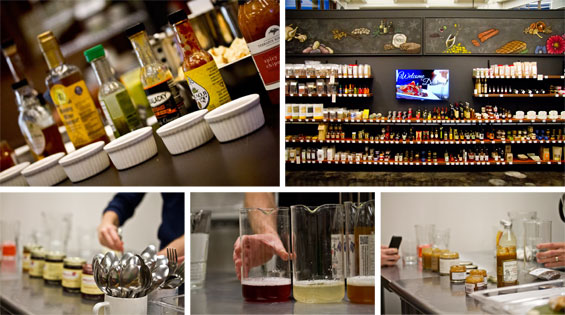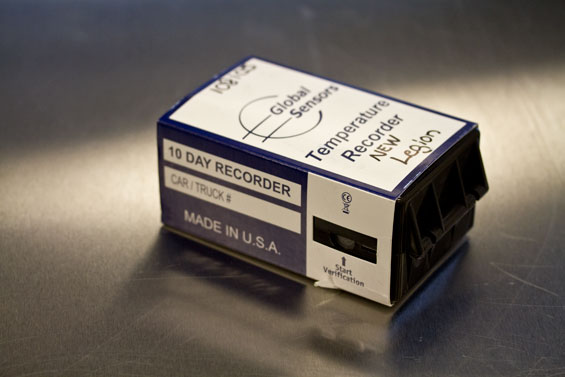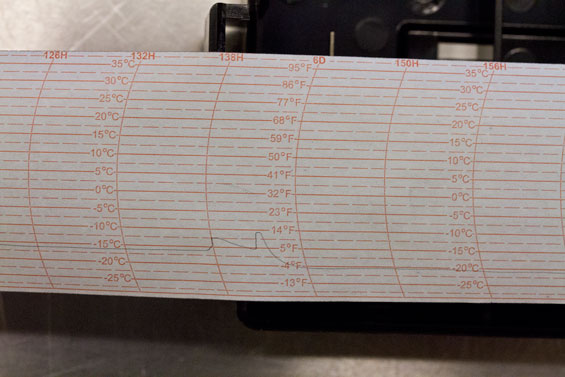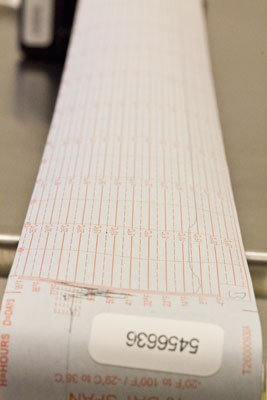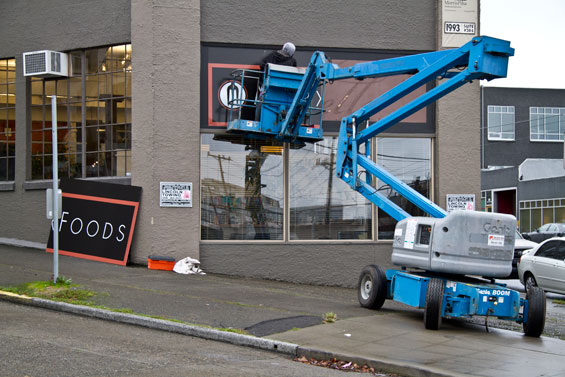| There’s nothing like going to a farm to realize how spoiled and disconnected I am from my food. In this case, my lessons came from the 100,000 acre Nokomai Station near Queenstown, New Zealand where 25,000 Silere Alpine-Origin Merino unknowingly grow our sweaters and protein in a lamb nirvana (and also one of the backdrops for the hobbit). | |
 |
|
| So, what do I take for granted? As a city-dwelling middle-to-upper class American, there most certainly is no end to the answer to that question. For now, I will just talk about the meat in my belly and wool on my back. | |
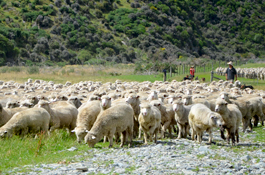 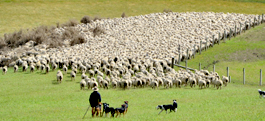 |
To observe the shepherds, the shearers, the pilots, the farmhands, the managers and the dogs do their work is to gain a mountain of appreciation and respect for all the work that goes into raising our meat and clothing. The only hard work we do is take a package of meat off the shelf and put it on a grill. We’ve got it easy. Being behind the scenes on a working ranch is to get a glimpse into the unending list of things that go into good farm management: pasture management, animal health, diet, selecting the right grass for the right species, logistics and getting the animals to the abbatoir. There’s the breeding and genetics and then the processing, distribution and marketing. Trust me, I am just categorically scratching the surface. I am not doing this list justice and anyone reading this that actually knows about ranching now knows that my understanding is basically at a preschool level. |
| There’s so many reasons why we are disconnected from our food. For one thing, it is a great luxury to be free from worry about acquiring our sustenance. Modern life gives us plenty else to worry about as well as the luxury of moving up Maslow’s pyramid. But the connection to our food is often intentionally obscured by marketers. For good reason — much of our food production is ugly. Feedlots are nasty, for example. | |
| But, there is also plenty of beauty in our food production. I have seen dozens of ranching operations and I can say for sure that Silere Alpine-origin Merino is the class of the world. It’s hard to impugn the ethics of eating meat when animals are raised this way. Nokomai Station, a vast 100,000 open range that has been raising lambs for generations, is epically gorgeous and pristine. I think the pictures speak for themselves. | 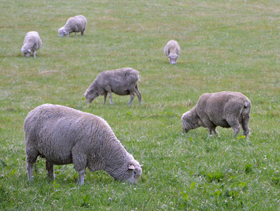 |
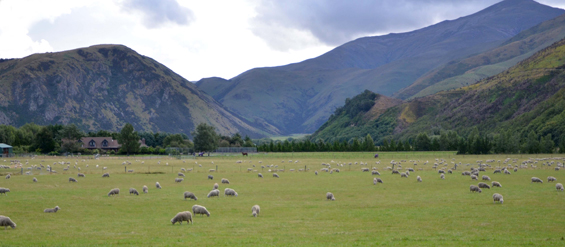 |
|
Check This Stud Out
| His name is “Infinity E3” and he is the man. Don’t believe me? Listen to this: E3 gets to mate with over a hundred cows a year. Every year. Wilt Chamberlain would have been jealous. |  |
| Before I met E3, his owner Daniel Absolom told me “the unique thing about E3 is his performance metrics.” Performance Metrics? Excuse me? | |
| It turns out that genetics is one of the three key factors in meat quality (the other two are on-farm management and processing). And that is why E3 is such a ladies man. Angus farmers want his | |
| genetics in their herd, so they are willing to pay handsomely for his offspring and his semen. | |
| I bet that’s something you never thought about while choosing a steak. | |
| Did you know that there are genetic markers for things like marbling and tenderness? In fact, there’s at least a dozen performance metrics that ranchers look for when purchasing breeding stock for their herds. E3’s offspring are in the top 69th percentile for rib fat and 68th percentile for rump fat, making him and his progeny likely to have great marbling. He’s in a whopping 83rd percentile for birth weight and upper 70th percentiles for all of the weight measurements, you know his kids are going to grow up nice and big. His scrotal size is in the 78th percentile which means that his male offspring will likely have big balls (ie big loads ie lots of semen to sell!). A short gestation length in his genes means that his female offspring can restart their reproductive cycle quicker. | |
| He’s basically in the upper percentiles for everything. Better genetics are more expensive, but also produce meat with better eating qualities. You get what you pay for. Want to try some grass-fed meat with impeccable genetics and, therefore, exceptional eating qualities? Order it here. | |
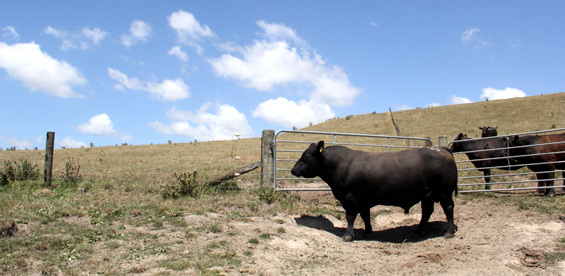 |
|
Antibiotics in Meat. An Argument for Sparing Use.
Ask a grass-fed cattle farmer, pretty much any grass-fed cattle farmer, about antibiotics and you will be greeted by a reaction that is a mix of defensive and dumbfounded, a reaction that is so uniform that you’d think they were reading off their talking points like a party politician.
Farmers insist that it would be inhumane to deny an animal antibiotics if their health or life depended on them. Just like we need to be medicated when we are sick, sometimes animals need to be medicated. One New Zealand farmer I spoke to said that he gives antibiotics to about 2 out of 1,000 cattle in any given year and then they have a 30 day waiting period before the animal can be sent to slaughter. This is basically what the claim “never fed sub-therapeutic antibiotics” means.
Personally, I would prefer to eat 100% antibiotic-free meat, but I realize that position is either: 1) rather elitist of me and/or 2) a slap in the face of animal welfare. Those who claim to sell “never-ever” meat simply put the medicated animal into separate production of 100% antibiotic-fed meat, so somebody is eating it, just not me. And, if the animal is not treated it could suffer needlessly from an infection.
I suspect that the reason why grass-fed farmers are often defensive about this question is because they feel that urbanites don’t understand that to deny antibiotics to an animal who is suffering is inherently inhumane. The grass-fed
farmers who I have met care deeply about the animals that they are raising. The reality is that animals that live on grass, with space, in a natural environment seldom need antibiotics so they are used sparingly in grass-fed operations.
The big problem arises when antibiotics are administered as a matter of practice and in large volumes. In North America, farmers order antibiotics from a catalog just like they order corn and they administer those antibiotics routinely to all of their animals. Feedlot cattle are fed antibiotics with their food because in a confined and crowded environment, a steady regimen of antibiotics is necessary to keep the animals growing and alive.
In New Zealand, antibiotics can only be administered by a vet to treat sick animals, there is a 30 day waiting period before that animal can be sent to the abbatoir and violation of this rule is apparently punished mercilessly by the authorities. I’m not sure if residues remain in the meat after 30 days, but maybe?
At this point I agree with the ranchers. If antibiotics are used extremely sparingly and administered only by a veterinarian, then we should treat sick animals rather than let them suffer. If that means that a small quantity of antibiotics enters the food supply, then that is a consequence that we should live with. There’s so many variables to balance. What do you think?
The Crosse Ranch – Animal Husbandry at its Finest
| Ben & Suzie Crosse raise beef cattle in Hawke’s Bay, New Zealand for the exceptional Grass-fed Angus Beef from Silver Fern Farms. While every Silver Fern Farms farmer-owner I have met operates at the gold standard of animal welfare, the Crosses must be the platinum standard. Ask Ben what the best part of farming is and he’ll tell you that he enjoys “spending time with the animals. The money is a sideshow.” It’s obvious that he means it from his heart. What’s the worst part, Suzie? “Having a thousand animals is like having a thousand children … there’s so much to worry about.” | 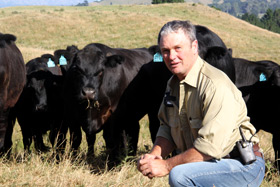 |
| The weather is the biggest worry. If it is too dry, the Crosses spend a lot of time figuring out how to rotate their cattle across slow-growing pastures in order to maintain the balance of keeping their herd fed on live grass and their pastures healthy. Too much rain makes for uncomfortable animals and that pulls on their heart strings. Farm animals are used to being outside, but I can imagine how being outside in the rain can get uncomfortable sometimes, even though there is abundant shelter on their land in the form of trees planted by Ben’s grandfather. It couldn’t have been more apparent that this family cares for their animals. Ben can read his herd’s body language just like you can read your dog. Their daughter bottle feeds the calves that don’t take to their mom. | |
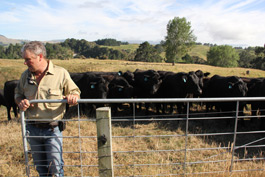 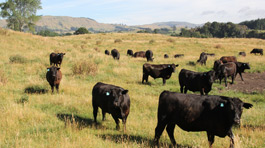 |
Ben’s knowledge and care for his herd is most clearly on display when it’s time to move the cattle to a new pasture. Cattle are curious creatures and they always come over, get within about 10 feet of us, and just stand there and stare. The cattle see us coming toward the gate and start coming over. They wait as we talk about Ben’s husbandry practices. After a few minutes Ben swings the gate open and the cattle rush through the gate and fan out in the new pasture. What’s the rush, I ask, because cattle are normally pretty docile and slow-moving. Ben says, “Because they are well-fed, they are a little picky. My cattle prefer clover and rye grass over the rest of the grasses in the pasture. They eat their favorite grasses first.” I looked at both pastures, trying to see the difference. Both have shin-high grass and I can’t see the difference. Well-fed cattle certainly see it. |
| In the Crosses, I see a family of ranchers that exemplify the triple bottom line concept. And you know what, they may not have even heard the term. Why would they? They don’t need fancy business school concepts. They live it. | 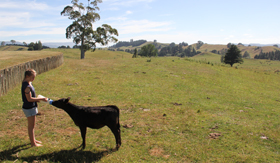 |
| There is a deep vein of environmetalism, humanity and pragmatism at the core of Silver Fern Farms’ Angus ranchers. Healthy, happy animals grow quickly and convert feed to muscle better. Asked why they are so focused on animal welfare, Ben has so many reasons: because it gives him satisfaction, because he genuinely cares about the animals, and because there’s no point in giving them good feed if they are going to metabolize it with nervous energy. That feed needs to be converted to muscle. If the cattle are relaxed they will focus on eating and they will metabolize more efficiently. Why doesn’t he use dogs with the cattle? Because cows get protective of their calves and if the cows get angry at the dogs, the calves will learn anger. He doesn’t want his cattle to learn anger. Wow! That blew me away. So cool. | |
| Environmental stewardship is a deeply held belief among these ranchers and I could tell that they were being real about it, not saying it as a part of marketing BS. The Crosses plant trees to create shelter for the animals but also habitat for wildlife. Nearby, the Absoloms dedicated a huge tract of their land to be a nature reserve, simply because they are thinking about the next generations. They know that their children will inherit this land. | 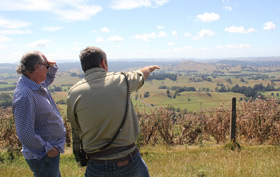 |
| We hop in Ben’s pickup and ride to the top of the hill. There’s nothing but grassy pastures and clusters of trees for miles and miles. Most of what we see on the horizon is land that’s grazed by his beef and lamb herds. Suzie points out the browner grass in the distance compared to the greener grass close-by. She says that as summer wears on, the brown grass creeps closer and closer, and with it creeps the worry about making sure that their cattle have abundant pasture. Good thing this herd is in good hands! | |
| I left the Crosse ranch with deep admiration for their business and their way of life, as well as a greater appreciation for the hard work and thoughtfulness that goes into our New Zealand Grass-fed Angus Beef. | |
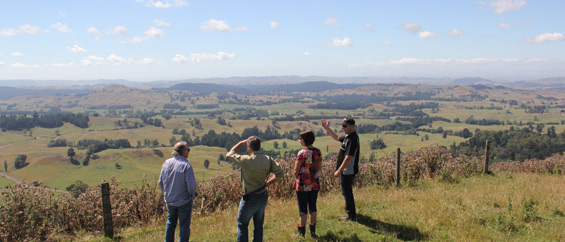 |
|
|
Post Written by Justin Marx |
|
The Absoloms – Genetics Masters
 |
|
| The Absoloms are your postcard-perfect ranching family… with the volume turned up: gorgeous land, classic farmhouse, gregarious and hospitable family. | |
 |
The Absoloms are in the business of raising breeding stock. What does that mean? Well, ranchers carefully manage the genetics of their herds. Traditionally, ranchers would selectively breed for particular traits and to avoid inbreeding. Today, it is remarkably more sophisticated. Via DNA testing, tracking offspring and probably so many other things that I don’t understand, ranchers can carefully manage their genetics to make sure their herd has fantastic eating qualities. Did you know, for example, that there are genetic markers for things like marbling and |
| tenderness and that most ranchers know the genetic quality of their animals before they add them to their herd? | |
| Certain ranchers, like the Absoloms, focus on raising breeding stock rather than raising animals for meat. They basically sell genetics in the form of young bulls and semen. One of their bulls, named Infinity E3, probably has a higher net worth than you or I. | |
| Once you meet this family, it is little surprise that the Absoloms are in the business of beef, lamb and venison genetics. John & Star Absolom also clearly have a premium breeding program as well for the humans on the ranch: just as their bulls have above average eating qualities, their family has above average looks and demeanors. To use their parlance, John has “sired” four strapping sons who also seem to have pulled down beautiful wives to continue the good genes breeding. We spent an evening with the family, had a blast, and attempted to wrap our minds around their very sophisticated breeding operation. We less successfully attempted to wrap our minds around their favorite sport: cricket. | 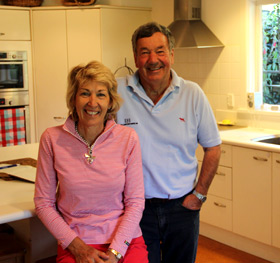 |
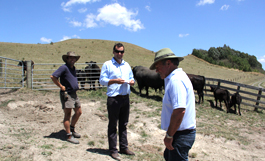 |
The important thing to know is that good genetics is the first step in producing quality meat and one of the big reasons why our New Zealand Grass-fed Beef from Silver Fern Farms is the best beef you have ever eaten. And, all you need to know for now about New Zealand cricket is that the Otago Volts are the reigning champs! |
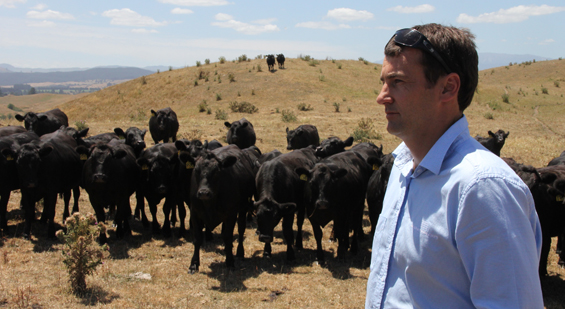 The Absoloms’ next door neighbors, the Crosses, are no less exceptional. Read their story here. The Absoloms’ next door neighbors, the Crosses, are no less exceptional. Read their story here. |
|
|
Post Written by Justin Marx |
|
I Didn’t Always Eat Meat
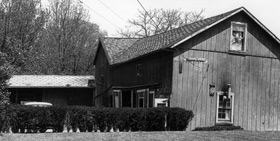 |
If ever there were a black sheep in the Marx family, I’m pretty sure I am it. I was raised in a slaughterhouse. I can trace my paternal lineage back 5 generations and all of them were butchers. My first job was in a slaughterhouse. Second in a packing plant. Third in a butcher shop. You get the picture. Yet, I gave up meat for about 7 years much to the dismay of my family. |
| I swear that I didn’t stop eating meat because of my wife who had been a vegetarian since second grade. Nobody believes me. Anyway, I stopped eating meat about 10 years ago when I started questioning my diet and reading voraciously about food politics. Diet for a New America by John Robbins was the tipping point. At the time I didn’t really have access to sustainable, humane meat. So, I dropped meat from my diet. | |
| Fast forward 10 years. February, 2013. I have been eating meat for a few years. I’m fresh back from a trip to New Zealand where I spent two weeks touring the ranches, abbatoirs and offices that are responsible for our Silver Fern Grass-fed Angus beef and soon-to-be-imported Silere Alpine-origin Merino. My notebook repeatedly asks questions like “How can one challenge the ethics of eating meat when the meat is raised like this?” |  |
| Marketing terms like “free range” and “grass-fed” barely do it justice. On one ranch that I visited, there were 25,000 Merino roaming 100,000 open acres of alpine pasture. It was lambs doing what lambs do. Vast healthy pastures. Lots of wildlife. Shepherds and ranchers that genuinely care for their herds. | |
| At the end of the trip, I still couldn’t think of an argument challenging the ethics of eating meat raised this way. Instead, I was repeatedly awestruck by the beauty of the land, the beauty of the animals and of the people who steward both. New Zealand meat production is the gold standard of sustainability, animal welfare and meat quality. Here’s some photos, because words cannot express. | |
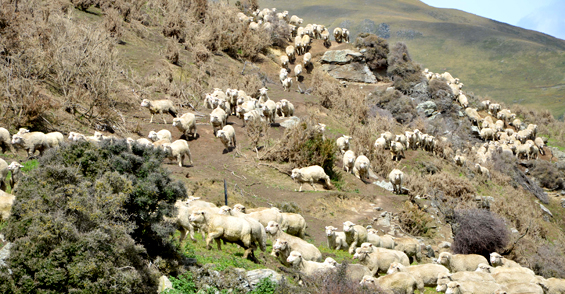 |
|
 |
|
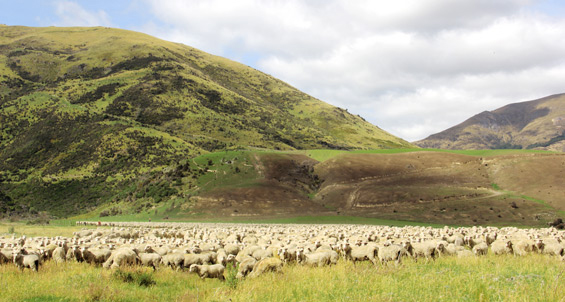 |
|
Nokomai Station is Lamb Nirvana
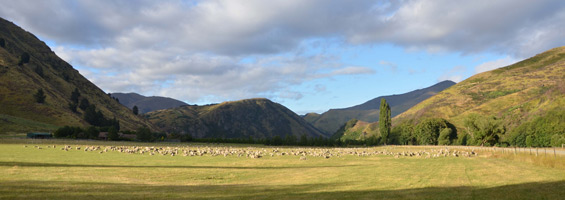 |
| 100,000 Alpine acres are the home of 25,000 Alpine-origin Merino. The Hore family have an impressive Merino wool and meat operation and are incredibly gracious hosts. In an absolutely idyllic environment they produce the finest lamb we have ever eaten (once we start importing it next month, we know you will agree. This stuff is the real deal). Pictures and videos tell the story far better than I can, so here goes: |
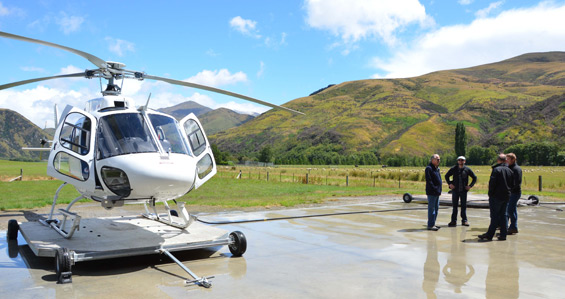 |
| The 100,000 acre range is vast and gorgeous and the only way to take it in is by helicopter. |
 |
| Alpine-origin Merino roam freely and eat native grasses and alpine herbs. That’s one of the reasons why their meat is so flavorful. In a couple months we will be introducing Silere Alpine-Origin Merino to the US market. |
| Lamb-valanche! This is what 4,300 lamb herded down a mountain looks like. |
 |
| Scenes for The Hobbit were filmed here. Every bit of land that you see is dotted with Silere Alpine-origin Merino. |
 |
| Sheep doing what sheep do. It’s hard to argue with the ethics of meat from animals raised so freely. |
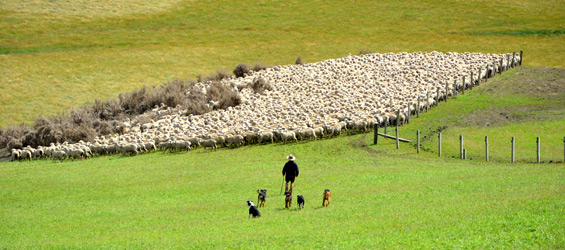 |
| Shepherds and dogs bring lamb down from the alpine country. |
 |
| The lower pastures are serene and picturesque |
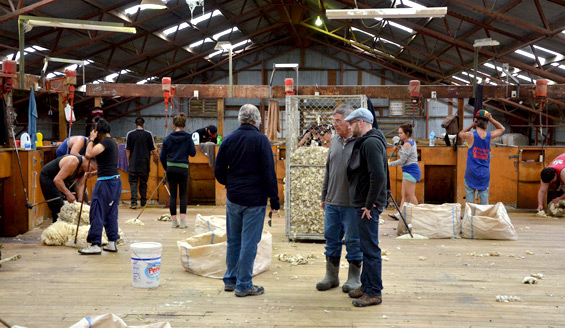 |
| Merino lamb being sheared. Just as merino wool is finer textured, Silere Alpine-origin Merino meat is also more finely textured. It has a fantastically silky mouthfeel compared to ordinary lamb. |
Silver Fern Farms & The Future
 |
|
| New Zealand is a lot of beautiful things. I came to learn about the origin of our grass-fed beef, lamb and venison, and was equally swept away by the people who produce it. The best meat in the world is raised on New Zealand’s vast grassy pastures as are some of the most hospitable, gracious and progressive people on the planet: the Absoloms, the Crosses and the Hore family. | |
| New Zealand is a place that has strong roots in heritage and tradition but is leading the world in producing top quality sustainable meat. It’s a place where ranchers care for their livestock the way their grandfathers did, while implementing a highly sophisticated meat quality program. | |
| New Zealand ranchers see the synergies between profitability, animal welfare and environmental stewardship. They walk that triple-bottom-line just as well as sustainability consultants talk it. The beautiful thing about New Zealand ranchers is that the triple bottom line is a way of life, instead of a corporate initiative. They may not have ever even heard of the term triple bottom line. It’s just natural and sensible to them. | 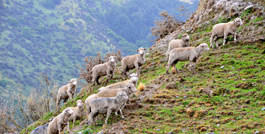 |
| They are environmental stewards because they appreciate a pure environment and because they are protecting it for their children. Almost every rancher tells a story about being the 3rd or 4th or 5th generation raising animals on their land and how they are holding it in trust for future generations. They truly care for their livestock not just because it enriches them monetarily, but also because it fulfills them to have healthy herds and because healthy cattle grow big and fast. They raise their animals in idyllic environments. Doing well and doing good are not mutually exclusive to them. | |
| New Zealand is a land of ranchers who work the land today but also have an eye to the future. And Silver Fern Farms is the glue that holds it all together. Silver Fern is a cooperative of farmers, an enormous co-op to be certain, with 16,000 farmer-owners. Silver Fern is developing a highly sophisticated “Eating Quality” program that is designed to take their already high standards to the next level. They have an elaborate system that involves tasting panels and the ability to tie the meat quality to on-farm practices, genetics and processing technique (the three things that play a big part in meat quality). They track metrics that begin with the animals’ birth and trace it to the steaks that taste testers eat. This revolutionary program essentially merges the technology of 2013 with the tried-and-true best practices of 1913 to determine how to elevate the quality of their meat. | |
| Silver Fern doesn’t just see the future, they are creating it. Their level of technological and marketing sophistication is decades ahead of their competitors. And that’s just one of the reasons why we are proud to sell their product in the US. | |
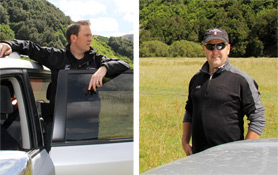 |
In upcoming posts, I will talk about some ranchers in particular, but the story would be incomplete without talking about some of the people at Silver Fern. On our two week tour, we spent most of our time with Glen McLennan (left) and Grant Howie (right). Glen takes care of our account. Ask Glen anything about animal husbandry, production, markets and he’s got the answer. And he knows what he is talking about. He’s a soft-spoken guy that’s a true professional. |
| Grant is part of the visionary team at Silver Fern that is elevating their business from a commodity producer into the new gold standard of quality and sustainability. Business school scholars should come here to see how the value chain and triple bottom line pervades their culture. Everyone I talked to at Silver Fern from members of the executive team to people working at the processing plant displayed sophisticated knowledge about their entire value chain in addition to their obvious expertise with their specific role in that chain. It is so abundantly clear that Grant and his colleagues are implementing a true value chain that produces the finest beef, lamb and venison in the world by connecting all of the dots from genetics, husbandry and butchery to packaging and marketing. Silver Fern is a near-army of intelligent, thoughtful people focused on putting the best possible sustainable steak on your plate. And they are excellent hosts. We are proud to offer their product and we look forward to the future with them. | |
Food Scouting 2013 Begins Next Week!
I AM IN THE MOOD TO FIND NEW FOOD PRODUCTS.
Look at me, screaming it! It’s a good thing I am in the mood because my first quarter is booked: New Zealand in January; Brooklyn in February; and Japan in March. That’s about 5 weeks of travel with a nearly singular objective: eat and scout, scout and eat. And I’ll still be the scrawniest bastard in the room!
Someone just asked me about my criteria for finding new food products. My initial reaction is rather unthoughtful: I don’t know, whatever I feel like, whatever is delicious. Realizing that answer to be insufficient, I thought more and realized that I’ve been scouting since my father walked me through every meat counter in sight. There’s a tremendous amount to the answer.
I’m sure that I could make my selection criteria into a neat little flow diagram. After all, I did to go business school and law school. But that’s boring. Bringing foods back to my tasting panel at my whim is much more fun. This is probably what my brain sounds like as I wander a market:
No. No. Oh, that’s disgusting. No. No, thank you. Yeah, pass on that one. Ew. Oooh, finally… a gem!
Finding distinctive specialty foods is a needle-in-a-haystack affair. That’s why your local retailer orders everything off a distributor’s catalog or two… it is HARD. Even at farmers markets and upscale retail shops, most of the stuff is not very distinctive. I do know that only 20% of the products that I bring back pass our tasting panel. I’d guess that I only bother to bring back 5% of the products that I consider … and that’s from products that I find at farmers markets and upscale grocers, a very high-quality sample. I’m not afraid to deny the fact that while I like to think that I’m fairly humble, when it comes to selecting new food products I am about as judgy as it gets.
So, here’s what I’m looking for: I’m looking for distinctive products, things you have never tasted before. I want uber-high-quality products, pure products, minimally manipulated products. I don’t really care that much about price because I know that a good product costs money to make and if the maker can’t make money, then he won’t make another batch. Everybody’s gotta eat. At the same time, it can’t be prohibitively expensive otherwise people won’t buy it. I want a clear flavor profile. I want pure ingredients, I want a short ingredient list. I want it as natural and sustainable and “organic” as possible. I want it made in small batches. I want to buy direct from the producer and I want to shake his hand when I meet him at the farmers market. I want all of the things that any progressive eater wants. I know that I am not going to always get them all, but I want as many as possible. Delicious is #1 though. On the production side, I want consistency, I want a producer that is easy to work with and a producer that will work with us. That’s the basics, but there are so many other small criteria.
Off to New Zealand…
Temperature Recorder
Retail signs are in!!
Friends & Family Party was a Blast!!!
On Tuesday we officially christened the Marx Foods retail store with a Friends & Family party. It was great to show everyone our new shop!
Outside Looking In:
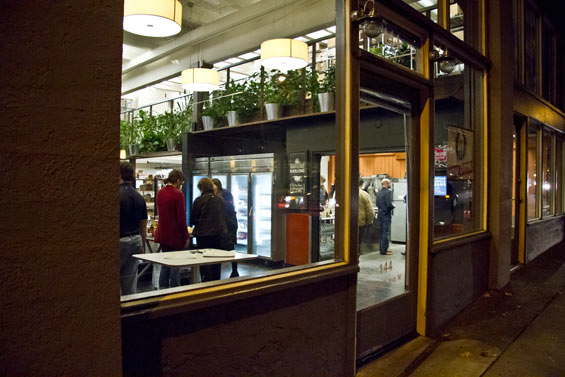
Inside Looking Out:
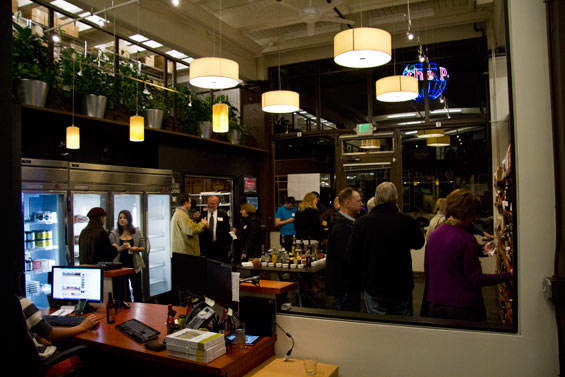
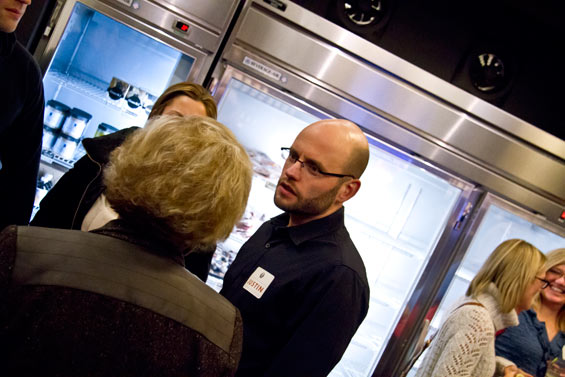
Of course, we aren’t just starting a new retail endeavor, we’re launching about a hundred new products! We had 35-40 of them out for people to try. Here are some of our new caramels, jams and spreads.
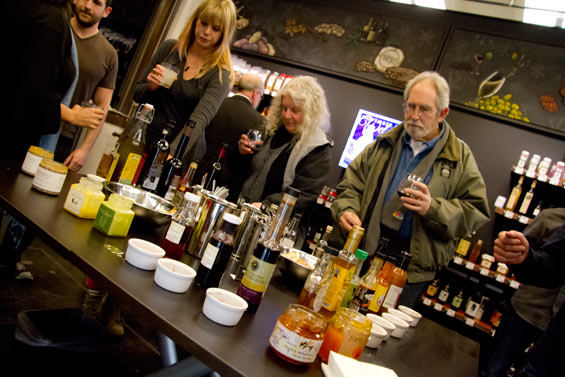
The pistachio cream appeared to be a universal favorite….people kept tasting it again and again;)
Our new hot sauces collection generated a lot of discussion as people argued over which one they liked best. Each of the four we had open offered very different flavor profiles, so there was something for everyone.
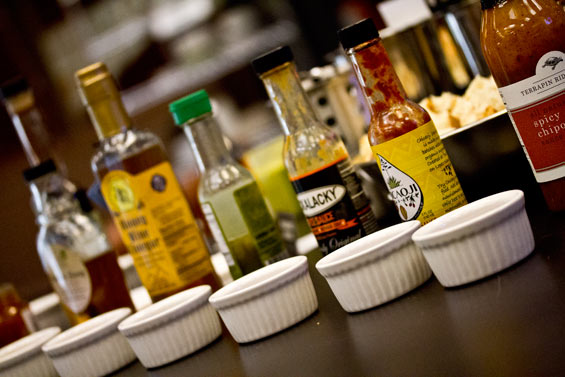
To make sure nobody went thirsty, Katie mixed up three signature cocktails featuring tart cherry grenadine, elderflower syrup, and yuzu juice, plus fresh sodas using our new lovage syrup, sarsaparilla syrup & hibiscus syrup.
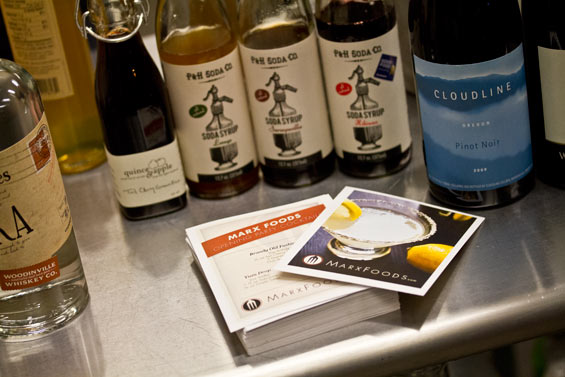
Come check us out at 144 Western Ave W. We’re open 11-7 weekdays and 10-3 on Saturdays.

